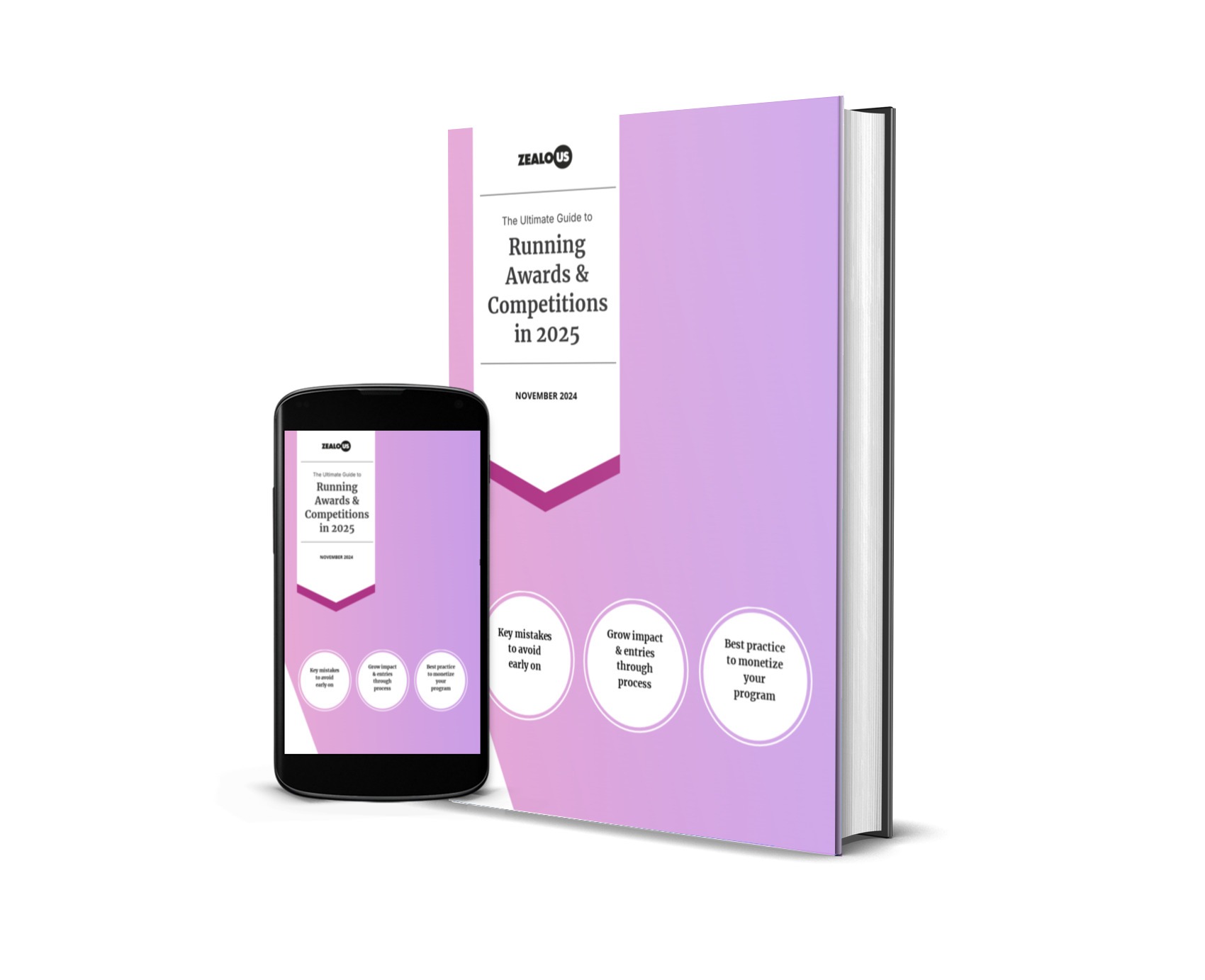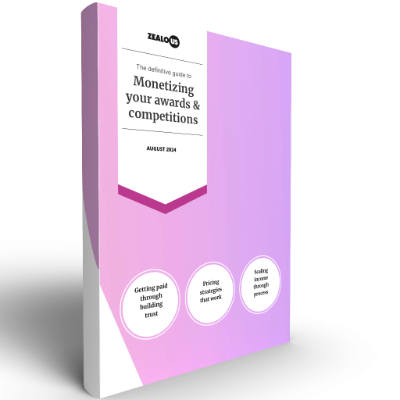This article covers:
- Why spreadsheets can cost you big money
- The real cost of poor promotion
- Silent killers that drains ROI
- The pitfalls of scaling
- Expenses beyond your award
- Digital solutions & awards management platforms
- Creating smooth entry experiences that reduce dropout
- The key to marketing better
- Tracking metrics that actually matter
- Managing post-programme work sustainably
Ever launched an awards programme only to watch your budget mysteriously evaporate?
You’re not alone (we’re two at least!).
Most awards managers budget for the obvious stuff: prizes, marketing, event space, maybe a nice trophy. But lurking beneath? Costs can creep up. Some hit you three months before launch; others surface mid-programme (when it’s expensive to fix!). But the worst only appear after your awards end, and everyone’s gone home.
This article shares the mistakes we’ve seen, exposes these hidden drains and (hopefully) shows you how to seal them early.
Manual process sink
Running an awards programme manually costs far more than the prize money, and the time you clock.
This usually surfaces 3 to 4 days before your deadline – when you realise your spreadsheet-and-email setup won’t scale to the number of entries in the last-minute push. Instead of celebrating your success in scaling, you’ll be scrambling trying to manage the fallout.
You’re juggling spreadsheets for entries, email threads with judges (who keep replying to the wrong thread), separate systems for communication, and somehow trying to compile results to make sense (without losing any application). Manual processes like data entry and document handling are time-consuming and prone to human error, often resulting in delays and increased overhead.
Manual processes are expensive – here is what they really cost you:
Time multiplied
If two team members each spend six hours weekly on admin tasks, that’s 288 hours over 6 months. At £25/hour, you’ve just spent £7,200 on repetitive work that could be automated (and that’s not counting time for training).
Dropout
If candidates face issues, or feel like you are disorganised, they may not bother entering. If you are taking a £20 fee, expecting 400 entries and 15% drop out because of the process – you’ve lost £1,400 in revenue.
Error correction
Misplaced documents. Miscommunication with judges. Data entry mistakes that cascade into bigger problems. Each error creates a ripple effect. It takes time to identify what went wrong, fix it, communicate the correction, verify it’s resolved, and apologise to whoever got affected.
Opportunity cost
Every hour spent on administrative grunt work is an hour not spent on the things that matter – strategic decisions, building relationships with candidates, improving your programme’s impact, or you know, sleeping.
Manual processes can actively harm your programme’s credibility when errors slip through. And they will slip through (even automation isn’t 100% perfect, but at least it’s much better). If you’re planning a new programme? Do yourself a big favour and build for automation from day one and spend time on optimising your process.
It’s far cheaper than retrofitting systems later when you’re stressed and over budget. Already mid-programme with manual chaos? You can still course-correct but expect a bumpy transition as you migrate data and train your team to use new systems. Automation need not be expensive but if your budget is (really) tight be sure to stress test your process with many more entries than you expect.
If you build it, they won’t come (without some effort)
Poor promotion doesn’t just mean fewer entries. It means all the effort you put into setting up your program is wasted (and you’re paying for it anyway).
Most programmes realise their marketing was inadequate about a month before their deadline. Too late to fully recover, but early enough to spend a fortune trying.
The maths is eye-watering. You budget £5,000 for marketing expecting 500 submissions. You get 150. That’s £33 per submission instead of £10 (that’s 3x more). Your prizes designed to create buzz reach fewer people. Any sponsors you might have will start questioning their involvement for next year (to them exposure and submission numbers are key).
This will spiral – Fewer participants means less word-of-mouth. Less buzz means sponsors lose interest. Disengaged sponsors reduce your budget for next year. Smaller budget forces you to cut marketing. Even fewer participants next round (or double the effort). If your goal was impact, then you’ve not optimised it.
See where this goes?
Recovering a programme’s reputation is far harder than building it correctly from the start. Sometimes impossible.
Begin promotion six to nine months before your deadline (our award marketing strategies can help). The smaller your marketing budget, the longer this will take. Build momentum gradually rather than one desperate push at the end when you’ve realised nobody knows you exist.
Download launch checklist
Never miss a critical step: 300+ tasks across 8 phases, from securing judges to winner announcement.
Get engaged engagement
Low engagement is the silent killer. Does this sound familiar – candidates start applications but never submit. They visit your site multiple times without acting. Judges accept roles then ghost you. Past winners don’t return or recommend the programme. Your community sees the programme as “just another award.”
Each weak touchpoint drains value. You’re getting poor return on your marketing investment, and your operational costs stay the same whether participants are engaged or not.
The simpler your process, the less you get in the way of your candidate’s optimism – give them a great experience and they become your greatest advocates. This typically becomes obvious mid-programme, when submission numbers lag and social media posts get minimal interaction. By then, there are no quick fixes, just a real need for clear and transparent communication on what you will do better next time.
Evolutionary tax
As you grow, you’ll need to accommodate more entrants, represent different demographics, add new categories, maintain quality across everything. These changes require additional resources that accumulate faster than you’d expect.
What evolution costs: training team members on new systems. Updating guidelines and communications. Scaling judge recruitment. Managing increased submission volumes. Adapting marketing to new audiences.
You budgeted for 300 submissions. You got 600. Success? Sure, but now you need twice the admin time, additional judge capacity, more robust systems. Your margins just got squeezed.
Building systems that scale from day one rather than break under pressure will save you time down the line (and if you’re curious we have a few tips here about planning your award schedule).
Scaling requires you to think of the time it takes to process an entry across the lifecycle of your program. If it takes an average of 50 seconds to process an entry (manually that would mean spreadsheets, downloading attachments, creating folders, preparing for the judges…so 50 seconds is very efficient) and you receive 500 – that’s 7 hours of processing time. Get 1,000 entries and you are looking at a very stressful 14 hours (and that’s if you don’t make mistakes). Automation could cut that down to 5 seconds per entry – a task you could do in a few hours.
Want more articles like this?
Give this one a like
The Solutions
Digital solutions
Technology is your first line of defence against most of these hidden costs. Awards management platforms function as central hubs for submission, tracking, review, judging, communication, and results. This eliminates juggling multiple tools (each with their own login you’ve forgotten), reduces errors dramatically, and frees your team for the strategic work that moves the needle. They also structure your programme based on best practice and gives it legitimacy.
Smooth entry experiences
Your submission process is your first impression. Make it brilliant, and candidates will celebrate you. Make it frustrating, and they’ll disappear like a ghost in the night (or worse be very loud about it on social media).
Ease of participation is the number one factor that makes consumers most excited about incentivised engagements. The rules are simple – remove friction, add support, make success feel achievable.
What seamless looks like: clear guidelines that answer questions before they’re asked, not vague corporate speak. Submission platforms that work intuitively on mobile and desktop (test this, seriously). Helpful error messages rather than “Error 404” or whatever. Progress indicators showing candidates how close they are to finishing. Allowing candidates to save drafts and edit them. Accessible support when questions arise, not an autoresponder saying someone will get back to them in five business days.
Every second you save candidates multiplies across every person who applies. Save them five minutes? With 500 submissions, that’s 2,500 minutes. Nearly 42 hours returned to the world. That’s more than a working week (if I was given back a week – I would finally take a holiday!).
Think about that from a diversity perspective too. Communities that need support most often have the least time available. Simplifying your process directly increases access and participation from underrepresented groups. It’s not just good UX, it’s good ethics and allows you to feature a richer pool of talent.
Insights like these straight to your inbox
Receive weekly tips from our founder to grow your program’s impact; regardless of what tools you use.
Tell (better) stories
People don’t connect with statistics. They connect with stories.
Share your programme’s mission in ways that create emotional resonance. Why does this award exist? Who does it serve? What change does it create? Answer these without resorting to corporate waffle.
Use storytelling to spotlight winners, judges, and the impact your programme creates. Each entrant’s story offers unique relatable content that resonates with different segments of your audience, emphasising diversity and inspiring participation.
Countdown campaigns build anticipation. Behind-the-scenes content demonstrates authenticity. User-generated content from past participants provides social proof far more powerful than anything you could say about yourself.
Real stories from real people create the emotional connection that transforms casual awareness into active participation.
Track what matters
You can’t improve what you don’t measure. Define success metrics at the start.
How will you know if your programme worked? More submissions? Higher engagement? Greater diversity? Sponsor satisfaction? Social impact? Decide now, not after it’s over. Awards & Competition metrics worth tracking are not limited to submission numbers and quality. Candidate diversity across relevant dimensions. Engagement rates at each stage. Marketing channel performance. Judge satisfaction. Winner outcomes six months later. Sponsor renewal rates.
Review these regularly. Mid-course corrections save programmes from disappointing outcomes. Data also protects you from hidden costs by revealing problems early. Drop-off rates spike at application? Your process is too complex. Judge retention falls. Their experience needs work. Certain demographics don’t apply? Your marketing isn’t reaching them.
Don’t forget budgets for post programme!
Your programme didn’t end when the ceremony finished (but you know that already if you’ve run any programme!).
First-time organisers get blindsided here. You’ve announced winners, celebrated publicly, and everyone’s exhausted. But the work and the costs continue for months afterward, and nobody budgeted for it.
What happens in the three to six months after your programme ends:
Winner relationship management
Your winners need ongoing support. They’re representing your programme, creating content, attending events, asking questions. Someone needs to coordinate this, respond to them, and maintain the relationship. This doesn’t happen by itself.
Impact measurement
If your programme exists to create change (not just hand out prizes and move on), you need to track your impact. Did winners gain opportunities? Did communities benefit? Did anything meaningful change? This requires follow-up surveys, interviews, and analysis. All costing time and potentially money.
Sponsor reporting
Your sponsors funded this expecting results and evidence of those results. Now you need to compile data, create reports, and demonstrate the value they received. Professional reporting takes 10 to 20 hours per major sponsor. More if they ask difficult questions.
Data analysis for improvement
What worked? What didn’t? Why did some things fail spectacularly? Analysing submission data, judging feedback, and participant surveys helps you improve next year, but someone needs dedicated time to do this properly. It won’t happen in the cracks between other work.
Community engagement during off-season
If you run annually, that’s 10+ months between programmes. How do you keep your community engaged so they remember you exist next time? Content creation, social media, networking—all require ongoing effort.
Archiving and documentation
Proper record-keeping for entries, especially if you handle sensitive information or have legal obligations. Storage costs, documentation time, and system maintenance don’t stop when the ceremony ends.
Most first-time organisers budget £0 for post-programme work. Experienced ones allocate 15 to 20% of their total programme budget to this phase because they’ve learned the hard way.
Don’t let post-programme costs surprise you when you’re tired and ready to move on.
Finally
Hidden costs don’t announce themselves. They accumulate quietly at different stages until suddenly your programme struggles and you’re not entirely sure why.
Manual processes drain time early in planning. Poor promotion wastes your infrastructure months before launch. Low engagement undermines everything mid-programme. Post-programme work demands resources when you’re exhausted and nobody’s left to help.
Protecting your programme means thinking across the full lifecycle, not just the exciting bits – our complete guide covers everything. Build systems that scale from day one. Market strategically six to nine months out, not three weeks before. Create engagement at every touchpoint. Budget for the three to six months after your ceremony ends when everyone else has forgotten about you.
The right platform eliminates most administrative burden before it starts. Clear communication builds trust throughout the cycle (not just when you need something). Compelling stories create emotional connections that last beyond the award announcement. Team support ensures sustainable operations rather than burnout cycles. Intentional inclusion broadens impact at every stage.
Your awards programme exists to celebrate achievement and create meaningful change. Don’t let hidden costs emerging at different times steal that potential because you didn’t plan properly.
Invest time in planning these areas across the full journey, and you’ll save countless hours fixing problems later. More importantly, you’ll create a programme that genuinely serves the communities it claims to support, not just one that looks good on paper.
We can help!
Zealous reduces the hidden costs of running awards
But we’re not alone in the space – here are 8 others you may wish to consider (even if we would prefer you choose us!).
Want us to write more content like this? Give it a like
Share

Guy Armitage is the founder of Zealous and author of “Everyone is Creative“. He is on a mission to amplify the world’s creative potential.
Frequently Asked Questions
How much does it really cost to run an awards programme?
Beyond obvious costs like prizes and marketing, hidden costs can add 30-50% to your budget. Manual processes alone can cost £7,200+ in staff time over 6 months, while poor engagement can waste your entire marketing budget. Most first-time organisers underestimate post-programme costs by failing to budget for winner support, impact measurement, and sponsor reporting.
What’s the biggest hidden cost in awards programmes?
Manual processes are the biggest drain. If two team members spend six hours weekly on admin tasks over 6 months, that’s £7,200 at £25/hour—before counting error correction, dropout, and opportunity costs. Automation from day one prevents these costs from emerging.
When should I start promoting my awards programme?
Begin promotion six to nine months before your deadline. Programmes that start marketing just a month before their deadline pay 3x more per submission and struggle to recover. The smaller your marketing budget, the earlier you need to start building momentum.
How can I reduce awards programme costs without compromising quality?
Three high-impact strategies: First, automate from day one—manual processing costs £7,200+ over 6 months and can be reduced to hours with the right platform. Second, write crystal-clear guidelines upfront to prevent the 15% dropout rate that costs £1,400+ in lost revenue. Third, start marketing 6-9 months early with smaller, consistent efforts rather than expensive last-minute campaigns that cost 3x more per submission.
What costs do organisers forget after the awards ceremony?
Post-programme costs consume 15-20% of your total budget but are often forgotten. These include winner relationship management, impact measurement, sponsor reporting (10-20 hours per sponsor), data analysis for improvements, off-season community engagement, and proper archiving—all requiring 3-6 months of ongoing work.
Should I use awards management software or spreadsheets?
Awards management platforms eliminate most hidden costs before they start. Spreadsheets seem cheaper initially but cost significantly more through manual processing time, human errors, dropout from poor user experience, and inability to scale. If you’re expecting 300+ entries, automation pays for itself immediately.









